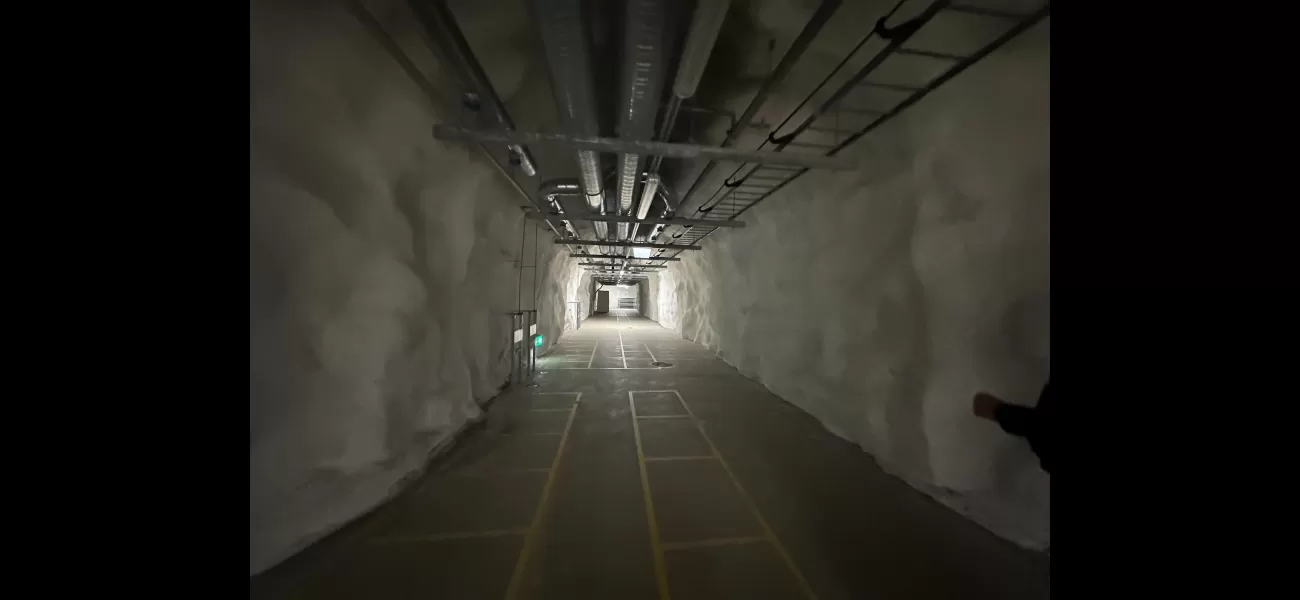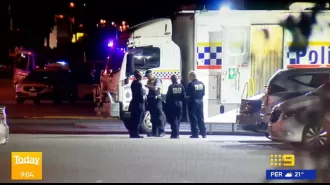A bomb shelter may become the world's safest playground with basketball courts and cafeterias.
Many European countries believed there would never be another war in Europe, but Finland has always looked ahead, planning for the future and future generations.
March 3rd 2024.

Deep below the bustling streets of Helsinki lies a network of shelters, quietly waiting for their moment of use in case of emergency. As I stroll through the Hakaniemi district, I can't help but notice posters advertising a demonstration marking the anniversary of the Russian invasion into Ukraine. It's hard to believe that just two years ago, on February 24, 2022, Europe experienced its first major conflict since World War II. But for Finland, this date holds a different significance.
Daniel Backström, a 49-year-old volunteer lead for the Finnish Civil Defence, explains the importance of preparation in Finnish history and how it has shaped their mindset. We stand 70 feet underground in a shelter built into solid bedrock, on the 80th anniversary of the Helsinki bombings in 1944. Along with other civil defence volunteers, he hands out informational leaflets about emergency preparedness and a mock newspaper chronicling the events of 1944. This was a pivotal moment in Finnish history, as the Soviet Union bombed cities across the country in an attempt to force them into peace negotiations. The attacks, which lasted throughout February, claimed hundreds of lives and left a lasting impact on the Finnish people.
Surprisingly, Finland was not taken aback by the news of Russia's invasion into Ukraine. This Nordic nation has always prioritized building shelters and funding their defence forces in case of such events. In fact, every man in Finland is required to undergo conscription, and every residential building must have a functional shelter. Mr Backström, who works as a forensic lab technician, joined the Civil Defence after the invasion into Ukraine, along with his wife. He saw it as a way to contribute to the civilian efforts in times of crisis.
The shelter we are in is massive, designed to accommodate up to 6,000 people in case of war, national emergency, or natural disasters. However, it doesn't feel like a typical shelter. The area is equipped with recreational sport courts, a children's play park, and a food court. Tomi Rask, a preparedness teacher with the Helsinki City Rescue Department, shows me around the sprawling underground shelter. We pass through several large metal doors, built to withstand toxic chemical weapons and nuclear blasts.
Mr Rask explains that these areas also serve as recreational spaces, as Finland has not experienced any wars in over 80 years. However, they are prepared for various emergencies such as flooding, storms, power outages, and water cuts. He opens the doors to another section of the shelter, and we are greeted by the sound of children playing in the nearby "Leikkiluola" or "cave for playing". There is also a food court nearby, but Mr Rask mentions that these businesses are required to evacuate within 72 hours in case of an emergency. He chuckles, recalling an American delegate who once called this "the world's most secure playground."
As we sit in the food court, the sounds of children's laughter fill the air. Mr Rask reflects on Finland's history with its neighboring country and the importance of being prepared. He mentions the monthly emergency siren tests, which have had some issues in the past. In fact, after the Russian invasion, people's interest in civil defence matters increased significantly. But Finland never stopped building shelters or being prepared, as they understand the importance of being ready for any situation. Conscription has always been a part of their culture, and they continue to prioritize it even during times of peace.
With its underground playground, recreational areas, and massive doors ready to be used in case of an emergency, Helsinki's shelters serve as a reminder of the country's preparedness and resilience. And as we leave the shelter and return to the bustling streets above, it's clear that this city is always ready for whatever may come its way.
Deep beneath the bustling streets of Helsinki lies a network of shelters, hidden from the public eye. These shelters serve as a safeguard for the city, in case of an emergency. As I make my way through the Hakaniemi district, I am bombarded by posters promoting a demonstration in the main square to commemorate the two-year mark of the Russian invasion into Ukraine. It's hard to believe that it has already been two years since the start of the first major conflict on European soil since World War II. But for Finland, this date holds a deeper significance.
As I continue my walk, I am greeted by Daniel Backström, a 49-year-old volunteer lead for the Finnish Civil Defence. We are standing 70 feet underground, in a shelter built into solid bedrock, on the 80th anniversary of the Helsinki bombings in 1944. Mr. Backström and his team of volunteers are busy distributing leaflets on emergency preparedness, offering tips on sheltering, and sharing a mock newspaper that recounts the events of 1944. It's a solemn reminder of the devastation that occurred when the Soviet Union bombed cities throughout Finland in an attempt to force the country into peace negotiations.
This tragic incident left a lasting impact on the Finnish people and their mindset. The bombings claimed hundreds of lives and forever changed the country's perspective on the importance of being prepared. Unlike the rest of the world, Finland was not taken by surprise when Russia invaded Ukraine. This Nordic country has always prioritized building shelters and funding their defense forces, in case of a similar event.
In fact, conscription is still mandatory for every man in Finland, and every residential building is required to have a functional shelter for emergencies, like the one Mr. Backström and I are currently standing in. He explains that his day job is a forensic lab technician, but he also volunteers as a lead for the Finnish Civil Defence, where he trains other civilians to assist in times of crisis. He shares that he and his wife joined the Civil Defence after the Russian invasion into Ukraine, feeling that they could contribute in some way, even if they were not able to fight on the front lines.
The shelter we are in is vast, with the capacity to hold up to 6,000 people. However, it doesn't feel like a typical shelter. Much of the space is dedicated to recreational activities, including basketball courts, a children's play area, and a food court. Tomi Rask, a preparedness teacher with the Helsinki City Rescue Department, takes me on a tour of the underground shelter. He points out the multiple metal doors designed to protect against chemical weapons and nuclear blasts. But he also mentions that these areas are also used for recreation, as Finland hasn't experienced war in over 80 years.
Mr. Rask leads me to another wing of the shelter, where we hear the joyful sounds of children playing in a nearby play area called "Leikkiluola," which translates to "cave for playing." He explains that the businesses operating in the shelter are required to vacate the premises within 72 hours in case of an emergency. He also shares a funny anecdote about an American delegate who once called this the "most secure playground in the world."
We take a seat in the food court, surrounded by the sounds of children playing in the background. Mr. Rask sighs and reflects on the relationship between Finland and its neighbor, Russia. He shares that Finland has always been aware of what Russia is capable of, as they have been through it before. He also mentions the monthly siren test, which takes place every first Monday of the month. While the system has had some issues in the past, it serves as a reminder to the public to always be prepared.
Mr. Rask recalls the first Monday in March 2022, after the Russian invasion into Ukraine, when the drill didn't go as smoothly as expected. This led to an increase in public interest and questions about civil defense matters. But he emphasizes that Finland has never stopped being prepared or building shelters, even during times of peace. The country understands the importance of being ready for any situation and has never stopped conscription.
In a world where conflict and emergencies can occur at any time, Finland serves as a shining example of the importance of being prepared. The shelters beneath Helsinki's streets are a testament to the country's proactive approach to protecting its citizens and ensuring their safety in times of need.
Daniel Backström, a 49-year-old volunteer lead for the Finnish Civil Defence, explains the importance of preparation in Finnish history and how it has shaped their mindset. We stand 70 feet underground in a shelter built into solid bedrock, on the 80th anniversary of the Helsinki bombings in 1944. Along with other civil defence volunteers, he hands out informational leaflets about emergency preparedness and a mock newspaper chronicling the events of 1944. This was a pivotal moment in Finnish history, as the Soviet Union bombed cities across the country in an attempt to force them into peace negotiations. The attacks, which lasted throughout February, claimed hundreds of lives and left a lasting impact on the Finnish people.
Surprisingly, Finland was not taken aback by the news of Russia's invasion into Ukraine. This Nordic nation has always prioritized building shelters and funding their defence forces in case of such events. In fact, every man in Finland is required to undergo conscription, and every residential building must have a functional shelter. Mr Backström, who works as a forensic lab technician, joined the Civil Defence after the invasion into Ukraine, along with his wife. He saw it as a way to contribute to the civilian efforts in times of crisis.
The shelter we are in is massive, designed to accommodate up to 6,000 people in case of war, national emergency, or natural disasters. However, it doesn't feel like a typical shelter. The area is equipped with recreational sport courts, a children's play park, and a food court. Tomi Rask, a preparedness teacher with the Helsinki City Rescue Department, shows me around the sprawling underground shelter. We pass through several large metal doors, built to withstand toxic chemical weapons and nuclear blasts.
Mr Rask explains that these areas also serve as recreational spaces, as Finland has not experienced any wars in over 80 years. However, they are prepared for various emergencies such as flooding, storms, power outages, and water cuts. He opens the doors to another section of the shelter, and we are greeted by the sound of children playing in the nearby "Leikkiluola" or "cave for playing". There is also a food court nearby, but Mr Rask mentions that these businesses are required to evacuate within 72 hours in case of an emergency. He chuckles, recalling an American delegate who once called this "the world's most secure playground."
As we sit in the food court, the sounds of children's laughter fill the air. Mr Rask reflects on Finland's history with its neighboring country and the importance of being prepared. He mentions the monthly emergency siren tests, which have had some issues in the past. In fact, after the Russian invasion, people's interest in civil defence matters increased significantly. But Finland never stopped building shelters or being prepared, as they understand the importance of being ready for any situation. Conscription has always been a part of their culture, and they continue to prioritize it even during times of peace.
With its underground playground, recreational areas, and massive doors ready to be used in case of an emergency, Helsinki's shelters serve as a reminder of the country's preparedness and resilience. And as we leave the shelter and return to the bustling streets above, it's clear that this city is always ready for whatever may come its way.
Deep beneath the bustling streets of Helsinki lies a network of shelters, hidden from the public eye. These shelters serve as a safeguard for the city, in case of an emergency. As I make my way through the Hakaniemi district, I am bombarded by posters promoting a demonstration in the main square to commemorate the two-year mark of the Russian invasion into Ukraine. It's hard to believe that it has already been two years since the start of the first major conflict on European soil since World War II. But for Finland, this date holds a deeper significance.
As I continue my walk, I am greeted by Daniel Backström, a 49-year-old volunteer lead for the Finnish Civil Defence. We are standing 70 feet underground, in a shelter built into solid bedrock, on the 80th anniversary of the Helsinki bombings in 1944. Mr. Backström and his team of volunteers are busy distributing leaflets on emergency preparedness, offering tips on sheltering, and sharing a mock newspaper that recounts the events of 1944. It's a solemn reminder of the devastation that occurred when the Soviet Union bombed cities throughout Finland in an attempt to force the country into peace negotiations.
This tragic incident left a lasting impact on the Finnish people and their mindset. The bombings claimed hundreds of lives and forever changed the country's perspective on the importance of being prepared. Unlike the rest of the world, Finland was not taken by surprise when Russia invaded Ukraine. This Nordic country has always prioritized building shelters and funding their defense forces, in case of a similar event.
In fact, conscription is still mandatory for every man in Finland, and every residential building is required to have a functional shelter for emergencies, like the one Mr. Backström and I are currently standing in. He explains that his day job is a forensic lab technician, but he also volunteers as a lead for the Finnish Civil Defence, where he trains other civilians to assist in times of crisis. He shares that he and his wife joined the Civil Defence after the Russian invasion into Ukraine, feeling that they could contribute in some way, even if they were not able to fight on the front lines.
The shelter we are in is vast, with the capacity to hold up to 6,000 people. However, it doesn't feel like a typical shelter. Much of the space is dedicated to recreational activities, including basketball courts, a children's play area, and a food court. Tomi Rask, a preparedness teacher with the Helsinki City Rescue Department, takes me on a tour of the underground shelter. He points out the multiple metal doors designed to protect against chemical weapons and nuclear blasts. But he also mentions that these areas are also used for recreation, as Finland hasn't experienced war in over 80 years.
Mr. Rask leads me to another wing of the shelter, where we hear the joyful sounds of children playing in a nearby play area called "Leikkiluola," which translates to "cave for playing." He explains that the businesses operating in the shelter are required to vacate the premises within 72 hours in case of an emergency. He also shares a funny anecdote about an American delegate who once called this the "most secure playground in the world."
We take a seat in the food court, surrounded by the sounds of children playing in the background. Mr. Rask sighs and reflects on the relationship between Finland and its neighbor, Russia. He shares that Finland has always been aware of what Russia is capable of, as they have been through it before. He also mentions the monthly siren test, which takes place every first Monday of the month. While the system has had some issues in the past, it serves as a reminder to the public to always be prepared.
Mr. Rask recalls the first Monday in March 2022, after the Russian invasion into Ukraine, when the drill didn't go as smoothly as expected. This led to an increase in public interest and questions about civil defense matters. But he emphasizes that Finland has never stopped being prepared or building shelters, even during times of peace. The country understands the importance of being ready for any situation and has never stopped conscription.
In a world where conflict and emergencies can occur at any time, Finland serves as a shining example of the importance of being prepared. The shelters beneath Helsinki's streets are a testament to the country's proactive approach to protecting its citizens and ensuring their safety in times of need.
[This article has been trending online recently and has been generated with AI. Your feed is customized.]
[Generative AI is experimental.]
0
0
Submit Comment





